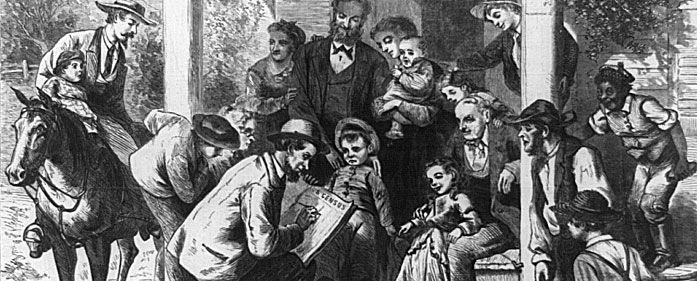Census pushing Dems to 2/3 majority


March 11, 2010
By JOHN SEILER
The most important political event in California this year might not be the races for governor or U.S. Senator, or the ballot initiatives in June and November. It might be the envelope that drops in your mailbox any day now from the U.S. Census Bureau. The actual mottos on its Census 2010 Web site: “It’s in our hands.” And: “We Can’t Move Forward Until You Mail It Back.”
The way millions of households fill out the forms – or don’t fill them out – will determine the future of California politics. To entice people to send in their forms, the bureau promises:
Better infrastructure. More services. A brighter tomorrow for everyone. In fact, the information the census collects helps to determine how more than $400 billion dollars of federal funding each year is spent on infrastructure and services….
But after that comes a threat: “Participation isn’t just important—it’s mandatory.” (Boldface in the original.)
However, as important as the doling out of federal tax dollars is, even more important is the calculation of populations to determine the districts for the U.S. House of Representatives and, in the California Legislature, the Assembly and Senate.
The U.S. House of Representatives
Although the Census today involves many questions, in the U.S. Constitution it originally was intended as a simple decennial “enumeration” to determine the number of seats each state got in the U.S. House of Representatives. This likely will be the first time since California joined the Union that a Census has not granted more seats, with the number remaining at 53. “The state gained nine seats — the most ever — after the 1930 census, seven after 1950, eight after 1960, seven after 1990 and one after the 2000 count,” reported the Los Angeles Times.
Other states, such as Texas, Arizona and Florida, are growing faster and are expected to pick up seats.
David Baggins, chair of the department of political science at Cal State East Bay, told me:
We’re not a particularly fast-growing state anymore. We will get no additional representatives in Congress. Things are changing for California. There are still immigrants from around the world coming to California. But California is emigrating to the other states. The African-American population is enormously decreasing, probably down to 4 percent in the Census. Whites will be down slightly. Latinos and Asians are increasing.
Baggins added:
The out-migration now [of African-Americans] is as powerful as the in-migration was in the 1940s. California is very expensive and is no longer an attractive state except above a certain level of wealth.
The changing state Legislature
More affected will be those elected to the state house in Sacramento. Currently, Democrats hold a majority in both houses. But they are just shy of the two-thirds supermajorities needed in both houses to pass a state budget without any Republican votes. To gain such supermajorities, Democrats would need four more seats in the Assembly and two more in the Senate.
Currently, Republicans have just enough votes to have some influence, although not much, on state budgets, especially in resisting tax increases. It took a lot of finagling of a handful of Republican legislators last year for them to cross the aisle and vote for Gov. Arnold Schwarzenegger’s $13 billion tax-increase package. And there long have been calls to drop the two-thirds rule to simple majority vote for passing a budget. That question soon may become moot.
With Latinos generally voting 70 percent Democratic, and their numbers growing, I wondered if the 2010 U.S. Census might increase their numbers enough in crucial districts to put the Democrats over the two-thirds threshold before the 2012 elections.
“Within the state, we probably will see an increase in Democratic-leaning areas,” Jack Pitney told me. He’s Roy P. Crocker Professor of American Politics at Claremont McKenna College, and author of American Government and Politics: Deliberation, Democracy and Citizenship. “Latinos generally are younger and have more children. They vote about 70 percent Democratic, depending on the poll.”
He pointed out that the Census counts not only citizens/voters, but children who are citizens, and all non-voting immigrants, whether legal or illegal. So a legal immigrant with two children would have no votes, but would count as “four” people on the Census.
Could such demographic shifts put Democrats over the magical two-thirds number? “That’s a possibility,” Pitney replied. “They’re getting that close. It means Republicans are going to have to work harder.”
Another factor, he pointed out, is the new Citizens Redistricting Commission, the result of Proposition 11, which voters passed in 2008. The reform is supposed to prevent the extreme gerrymandering of recent reapportionments, especially after the 2000 Census, that made districts so lopsidedly Democratic or Republican, the districts almost never changed party hands. Of the Commission, Pitney said, “I don’t think anybody knows what kind of product they’re going to produce because they’ve never done it before.”
So, what would happen if Democrats do actually get two-thirds majorities in both houses after the 2012 election? “If Jerry Brown also is governor, two words come to the fore: tax increases.” Brown, also, is a Democrat.
Baggins was skeptical. After the Census, he said, “I don’t see a big shift. California strikes me as more moderate over time. Californians don’t really like Democrats or Republicans. They like initiatives. America is a republic. California is a democracy. The California Legislature is the least powerful of all the legislatures in the United States.”
Rogue elements
A final factor is unpredictable: Census protesters who are using Internet news, blog and video sites to discourage cooperation. The popular Libertarian Web site LewRockwell.com has run several anti-Census pieces: here, here and here. Rep. Ron Paul, who last month won a straw poll at the Conservative Political Action Conference for a potential presidential run in 2012, wrote, “Census: A Little Too Personal.”
And YouTube has many anti-Census videos, such as this one by Jerry Day, which was viewed 183,152 times, as of mid-March 2010.
It’s impossible to know how many people are taking an anti-Census stance. No poll has been taken about them; and those refusing to talk to a Census taker are unlikely to talk to a pollster.
I couldn’t find any data, but the anti-Census activists seem to be predominantly white males who vote Republican. Could their non-participation in the Census – meaning white men would be undercounted – affect elections, such as to the California Legislature?
“If history is any guide, the effect would be minimal in statistical effect,” Pitney said. “But in an election, there are no minimal effects.”
An obvious example was the 2000 presidential election, where some hanging chads and a couple hundred voters who mistakenly voted for Pat Buchanan instead of Al Gore ended up electing George W. Bush.
Pitney continued, “Even 1 percent abstaining could shift an election – probably in a direction the people abstaining don’t intend.”
The law of unintended consequences has not been repealed. Especially not in California politics.
John Seiler, an editorial writer with The Orange County Register for 19 years, is a reporter and analyst for CalWatchDog.com. His email: writejohnseiler@gmail.com.
Related Articles
Pro-Tax Villines Slams Taxes
John Seiler: I just got a mailer from from JobsPAC, a 527 organization, touting Republican Mike Villines, who’s running for insurance
Obama Backs High-Speed Boondoggle
John Seiler: Presidents live in a cocoon. Inside the cocoon are a few advisers and Secret Service agents. The cocoon
VIDEO: Will battle tanks replace think tanks?
Politics is a contact sport, so is it time for think tanks to transition from academic institutions to partisan brawlers?



